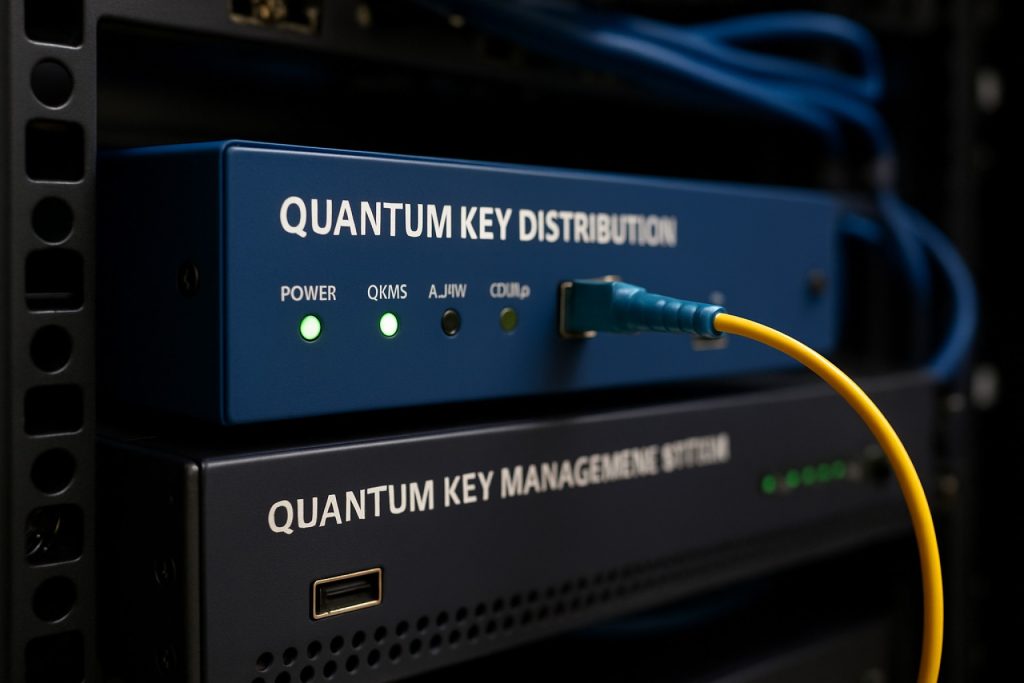
Quantum Key Management Systems Market Report 2025: In-Depth Analysis of Growth Drivers, Technology Innovations, and Global Forecasts. Explore Key Trends, Competitive Dynamics, and Strategic Opportunities Shaping the Industry.
- Executive Summary and Market Overview
- Key Technology Trends in Quantum Key Management Systems
- Competitive Landscape and Leading Players
- Market Growth Forecasts and Revenue Projections (2025–2030)
- Regional Analysis: Market Share and Emerging Hotspots
- Future Outlook: Strategic Roadmap and Industry Evolution
- Challenges, Risks, and Opportunities for Stakeholders
- Sources & References
Executive Summary and Market Overview
Quantum Key Management Systems (QKMS) represent a transformative advancement in cryptographic infrastructure, leveraging the principles of quantum mechanics to generate, distribute, and manage encryption keys with unprecedented security. As of 2025, the QKMS market is positioned at the intersection of rising cybersecurity threats and the accelerating development of quantum computing, which threatens to render classical encryption methods obsolete. QKMS solutions are designed to future-proof data protection strategies, particularly for sectors with stringent security requirements such as finance, government, defense, and critical infrastructure.
The global QKMS market is experiencing robust growth, driven by increasing investments in quantum-safe security and the proliferation of quantum communication networks. According to International Data Corporation (IDC), the quantum security market—including QKMS—is projected to grow at a CAGR exceeding 30% through 2030, with North America and Europe leading adoption due to regulatory pressures and early infrastructure deployment. Asia-Pacific is also emerging as a significant growth region, propelled by government-backed quantum initiatives in China, Japan, and South Korea.
Key market drivers include the rapid evolution of quantum computing capabilities, which pose a credible threat to RSA and ECC-based cryptography, and the increasing frequency of high-profile data breaches. Organizations are proactively seeking QKMS solutions to ensure compliance with evolving standards such as those from the National Institute of Standards and Technology (NIST) and to mitigate the risk of “harvest now, decrypt later” attacks. The integration of QKMS with existing Public Key Infrastructure (PKI) and cloud-based services is also accelerating adoption, as enterprises seek seamless migration paths to quantum-safe architectures.
The competitive landscape is characterized by a mix of established cybersecurity vendors and specialized quantum technology firms. Notable players include ID Quantique, Toshiba Corporation, and QuantumCTek, all of which are actively expanding their QKMS portfolios and forging strategic partnerships with telecom operators and cloud service providers. Venture capital investment in quantum security startups is also on the rise, reflecting strong market confidence in the sector’s long-term potential.
In summary, the QKMS market in 2025 is defined by rapid technological innovation, increasing regulatory scrutiny, and a growing imperative for quantum-resilient security solutions. As quantum computing approaches practical viability, QKMS adoption is expected to accelerate, reshaping the global cybersecurity landscape.
Key Technology Trends in Quantum Key Management Systems
Quantum Key Management Systems (QKMS) are rapidly evolving as organizations prepare for the advent of quantum computing and its implications for cryptography. In 2025, several key technology trends are shaping the development and deployment of QKMS, reflecting both advances in quantum technologies and the urgent need for quantum-safe security solutions.
- Integration with Quantum Key Distribution (QKD): QKMS are increasingly being designed to seamlessly integrate with Quantum Key Distribution networks, enabling the secure generation and distribution of cryptographic keys using quantum mechanics. This integration is being driven by pilot deployments in sectors such as finance and government, with companies like Toshiba and ID Quantique leading the way in commercial QKD solutions.
- Hybrid Cryptography Approaches: As quantum computers capable of breaking classical encryption are not yet widely available, QKMS are adopting hybrid models that combine quantum-generated keys with post-quantum cryptographic algorithms. This dual approach ensures backward compatibility and future-proofs security infrastructures, as recommended by organizations such as the National Institute of Standards and Technology (NIST).
- Cloud-Based Quantum Key Management: The rise of cloud computing is influencing QKMS architectures, with major cloud providers like Google Cloud and Microsoft Azure exploring quantum-safe key management as a service. This trend is making quantum-secure key management more accessible to enterprises without the need for specialized on-premises hardware.
- Standardization and Interoperability: Industry bodies such as the European Telecommunications Standards Institute (ETSI) are accelerating efforts to standardize QKMS protocols and interfaces. This is crucial for ensuring interoperability between different vendors and across international borders, especially as global supply chains and cross-border data flows become more reliant on quantum-safe security.
- Hardware Security Module (HSM) Integration: QKMS are being integrated with next-generation HSMs that support quantum-safe operations. Vendors like Thales are developing HSMs capable of managing both classical and quantum keys, providing a bridge for organizations transitioning to quantum-resilient infrastructures.
These trends underscore the dynamic landscape of QKMS in 2025, as the industry balances innovation, standardization, and practical deployment to address the looming threat of quantum-enabled cyberattacks.
Competitive Landscape and Leading Players
The competitive landscape for Quantum Key Management Systems (QKMS) in 2025 is characterized by rapid technological advancements, strategic partnerships, and a growing influx of both established cybersecurity firms and quantum technology startups. As organizations worldwide prepare for the quantum era, the demand for robust key management solutions that can withstand quantum computing threats is intensifying, driving innovation and competition in this niche but critical segment.
Leading players in the QKMS market include a mix of global technology giants and specialized quantum security firms. IBM has been at the forefront, leveraging its expertise in quantum computing to develop integrated QKMS solutions that complement its broader quantum-safe cryptography portfolio. ID Quantique, a pioneer in quantum-safe security, continues to expand its QKMS offerings, focusing on interoperability and compliance with emerging standards. Toshiba has also made significant strides, particularly in the Asia-Pacific region, by deploying QKMS as part of its end-to-end quantum communication networks.
Other notable players include QuantumCTek, which is capitalizing on China’s national quantum initiatives, and ETSI members who are actively shaping QKMS standards and protocols. Startups such as Quantinuum and Qrypt are gaining traction by offering cloud-based QKMS platforms and collaborating with telecom operators to enable secure key distribution over existing infrastructure.
Strategic alliances are a defining feature of the competitive landscape. For example, BT Group has partnered with Toshiba to pilot QKMS in metropolitan networks, while Atos is working with European research consortia to integrate QKMS into critical infrastructure protection projects. These collaborations are essential for scaling QKMS deployments and ensuring interoperability across diverse network environments.
Market competition is further intensified by ongoing standardization efforts and government-backed quantum security initiatives, particularly in North America, Europe, and East Asia. As the threat of quantum-enabled cyberattacks becomes more imminent, the QKMS market is expected to see continued consolidation, with leading players investing heavily in R&D and ecosystem partnerships to maintain their competitive edge.
Market Growth Forecasts and Revenue Projections (2025–2030)
The market for Quantum Key Management Systems (QKMS) is poised for significant expansion in 2025, driven by escalating concerns over quantum computing threats to classical encryption and the increasing adoption of quantum-safe security solutions across critical sectors. According to projections by MarketsandMarkets, the global quantum cryptography market—which includes QKMS—is expected to grow at a compound annual growth rate (CAGR) exceeding 35% from 2025 through 2030, with QKMS representing a substantial and rapidly expanding segment within this market.
Revenue forecasts for QKMS in 2025 indicate a market size approaching $250 million, with robust growth anticipated as pilot projects transition to full-scale deployments, particularly in the banking, government, and telecommunications sectors. The increasing frequency of cyberattacks and regulatory mandates for quantum-resilient infrastructure are compelling organizations to invest in advanced key management solutions. Notably, the Asia-Pacific region is projected to outpace other geographies in QKMS adoption, fueled by large-scale government initiatives in China, Japan, and South Korea to secure national communications networks using quantum technologies (IDC).
By 2030, the QKMS market is forecasted to surpass $1.5 billion in annual revenues, underpinned by the commercialization of quantum networks and the integration of QKMS with existing public key infrastructure (PKI) systems. The transition from proof-of-concept to operational deployment is expected to accelerate as interoperability standards mature and as leading technology vendors—such as IBM, Toshiba, and ID Quantique—expand their QKMS offerings and form strategic partnerships with telecom operators and cloud service providers.
- Financial services and government are projected to account for over 60% of QKMS revenues in 2025, reflecting their heightened risk exposure and regulatory requirements.
- Managed QKMS services are expected to gain traction, enabling organizations to adopt quantum-safe key management without significant upfront capital expenditure.
- Ongoing R&D investments and public-private collaborations are likely to drive further innovation and cost reductions, broadening the addressable market for QKMS solutions.
In summary, 2025 marks a pivotal year for the QKMS market, with strong revenue growth and a clear trajectory toward mainstream adoption by the end of the decade.
Regional Analysis: Market Share and Emerging Hotspots
The global market for Quantum Key Management Systems (QKMS) is witnessing dynamic regional shifts as adoption accelerates in response to growing cybersecurity threats and the impending advent of quantum computing. In 2025, the Asia-Pacific (APAC) region is emerging as a significant hotspot, driven by substantial investments in quantum communication infrastructure by governments and major technology firms in China, Japan, and South Korea. According to International Data Corporation (IDC), APAC is projected to account for over 35% of the global QKMS market share by the end of 2025, outpacing traditional leaders in North America and Europe.
China, in particular, is at the forefront, leveraging its national quantum communication backbone and aggressive R&D funding. The Chinese government’s Quantum Experiments at Space Scale (QUESS) project and the expansion of quantum-secured metropolitan area networks in cities like Beijing and Shanghai have catalyzed commercial deployments of QKMS solutions. Huawei Technologies and ZTE Corporation are among the key players driving domestic adoption and export of QKMS technologies.
In North America, the United States maintains a strong presence, accounting for approximately 30% of the global market share in 2025, according to Gartner. The region’s leadership is underpinned by robust investments from both the public sector—such as the National Quantum Initiative Act—and private sector innovation from companies like IBM and Microsoft. However, regulatory uncertainty and the complexity of integrating QKMS with legacy systems have somewhat tempered the pace of widespread deployment.
Europe is also a notable player, with the European Union’s Quantum Flagship program fostering cross-border collaboration and standardization efforts. Germany, the UK, and the Netherlands are leading the charge, with a combined market share of around 20% in 2025, as per Statista. The focus in Europe is on interoperability and compliance with stringent data privacy regulations, which is shaping the development and adoption of QKMS solutions.
Emerging hotspots include the Middle East, where countries like the UAE and Israel are investing in quantum-safe infrastructure for critical sectors such as finance and defense. These regions, while currently representing a smaller share, are expected to see double-digit growth rates through 2027, positioning them as future contenders in the QKMS landscape.
Future Outlook: Strategic Roadmap and Industry Evolution
The future outlook for Quantum Key Management Systems (QKMS) in 2025 is shaped by accelerating advancements in quantum computing, increasing cybersecurity threats, and evolving regulatory landscapes. As quantum computers approach practical viability, the urgency for quantum-safe cryptographic solutions intensifies, positioning QKMS as a critical component in the next generation of secure communications infrastructure.
Strategically, industry leaders are prioritizing interoperability and scalability in QKMS development. Major technology vendors and telecom operators are collaborating to integrate QKMS with existing Public Key Infrastructure (PKI) and network management systems, ensuring seamless transition and backward compatibility. For instance, IBM and Toshiba have announced pilot projects that combine QKMS with classical encryption protocols, aiming to provide hybrid security solutions that can withstand both classical and quantum attacks.
The industry roadmap for 2025 emphasizes the following strategic directions:
- Standardization: Global standards bodies such as the European Telecommunications Standards Institute (ETSI) and NIST are accelerating efforts to define interoperability and security benchmarks for QKMS, which is expected to drive broader adoption and vendor alignment.
- Commercialization: Early adopters in finance, government, and critical infrastructure are moving from pilot deployments to commercial-scale rollouts. BT Group and China Telecom have both announced plans to expand their quantum-secured networks, leveraging QKMS for key distribution and lifecycle management.
- Integration with Quantum Networks: As quantum communication networks expand, QKMS will play a pivotal role in managing keys across distributed quantum nodes. Initiatives like the European Quantum Communication Infrastructure (EuroQCI) are setting the stage for continent-wide quantum-secured data exchange, with QKMS as a foundational layer.
- Cloud and Edge Deployment: Cloud service providers such as Google Cloud and Microsoft Azure are exploring QKMS integration to offer quantum-safe key management as a service, addressing the needs of distributed and edge computing environments.
By 2025, the evolution of QKMS will be marked by increased standardization, commercial adoption, and integration with both classical and quantum networks. The industry’s strategic roadmap is focused on ensuring that QKMS solutions are robust, scalable, and ready to meet the security demands of a quantum-enabled future.
Challenges, Risks, and Opportunities for Stakeholders
Quantum Key Management Systems (QKMS) are emerging as a critical component in the transition to quantum-safe cryptography, but their adoption in 2025 presents a complex landscape of challenges, risks, and opportunities for stakeholders across industries.
Challenges and Risks:
- Integration Complexity: Integrating QKMS with existing IT infrastructure is a significant hurdle. Legacy systems are not designed for quantum protocols, requiring substantial upgrades or replacements, which can be costly and disruptive. According to Gartner, over 60% of enterprises cite integration as a primary barrier to quantum security adoption.
- Standardization Gaps: The lack of universally accepted standards for QKMS creates interoperability issues. While organizations like ETSI and NIST are working on frameworks, the absence of finalized standards in 2025 increases the risk of vendor lock-in and fragmented solutions.
- Cost and Resource Constraints: Deploying QKMS requires specialized hardware (e.g., quantum random number generators, QKD devices) and skilled personnel. IDC reports that the high upfront investment and ongoing operational costs deter many small and mid-sized enterprises from early adoption.
- Security Risks: While QKMS promises enhanced security, implementation flaws or side-channel vulnerabilities could be exploited. The evolving threat landscape, including quantum-enabled attacks, necessitates continuous monitoring and rapid response capabilities.
Opportunities:
- First-Mover Advantage: Organizations that invest early in QKMS can position themselves as leaders in quantum-safe security, gaining trust from customers and partners concerned about future-proofing sensitive data.
- Regulatory Compliance: As governments and regulators begin to mandate quantum-resistant security measures, early adopters of QKMS will be better prepared to meet compliance requirements, reducing the risk of penalties and reputational damage. The European Union Agency for Cybersecurity (ENISA) has already signaled forthcoming guidelines on quantum-safe cryptography.
- New Business Models: The rise of QKMS opens opportunities for vendors to offer managed quantum security services, consulting, and integration solutions, as highlighted by Accenture in its 2024 quantum technology outlook.
- Cross-Industry Collaboration: The complexity of QKMS implementation encourages collaboration between technology providers, telecom operators, and enterprises, fostering innovation and accelerating the development of interoperable solutions.
In summary, while the path to widespread QKMS adoption in 2025 is fraught with technical, operational, and economic challenges, the potential rewards for proactive stakeholders are substantial, particularly as quantum threats become more imminent.
Sources & References
- International Data Corporation (IDC)
- National Institute of Standards and Technology (NIST)
- ID Quantique
- Toshiba Corporation
- National Institute of Standards and Technology (NIST)
- Google Cloud
- Thales
- IBM
- Quantinuum
- Qrypt
- BT Group
- Atos
- MarketsandMarkets
- Huawei Technologies
- ZTE Corporation
- Microsoft
- Statista
- Toshiba
- China Telecom
- European Union Agency for Cybersecurity (ENISA)
- Accenture



